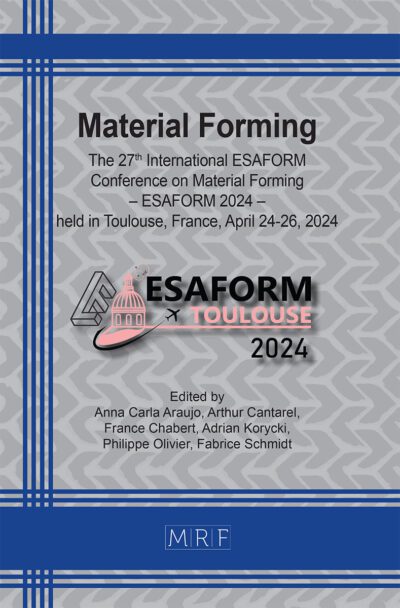Injection molding simulations for the manufacturing of polymer hollow microneedles
Pol Vanwersch, Tim Evens, Sylvie Castagne, Albert Van Bael
Abstract. Polymer hollow microneedles (HMNs) offer significant potential in medical, diagnostic, and cosmetic applications due to their minimally invasive nature and high replication capability. However, their fabrication using injection molding with ultrashort pulsed laser ablated molds presents several challenges, particularly in predicting process outcomes such as cavity filling and replication fidelity. This study investigates the role of injection molding simulations in addressing these challenges, focusing on the influence of the venting boundary conditions. Moldex 3D 2023 and 2024 versions are compared with and without the inclusion of venting boundary conditions, showing the importance of venting for the prediction of HMN heights. The 2023 version underestimates the filling height by 45%, while the 2024 version overestimates it by 18%. Furthermore, manual air volume calculations using the ideal gas law revealed deviations in both versions: the 2023 version significantly overestimates the entrapped air volume, while the 2024 version underestimates it. These findings indicate the necessity for more accurate algorithms to model compressible air dynamics in micro-scale geometries effectively. By addressing these challenges and improving the predictive accuracy of injection molding simulations, further research can pave the way for reducing trial-and-error in process development, lowering manufacturing costs, and enabling scalable production of HMNs.
Keywords
Injection Molding, Moldex3D, Entrapped Air, Micro-Features, Microneedles
Published online 5/7/2025, 9 pages
Copyright © 2025 by the author(s)
Published under license by Materials Research Forum LLC., Millersville PA, USA
Citation: Pol Vanwersch, Tim Evens, Sylvie Castagne, Albert Van Bael, Injection molding simulations for the manufacturing of polymer hollow microneedles, Materials Research Proceedings, Vol. 54, pp 2352-2360, 2025
DOI: https://doi.org/10.21741/9781644903599-254
The article was published as article 254 of the book Material Forming
![]() Content from this work may be used under the terms of the Creative Commons Attribution 3.0 license. Any further distribution of this work must maintain attribution to the author(s) and the title of the work, journal citation and DOI.
Content from this work may be used under the terms of the Creative Commons Attribution 3.0 license. Any further distribution of this work must maintain attribution to the author(s) and the title of the work, journal citation and DOI.
References
[1] K. Ita, Transdermal Delivery of Drugs with Microneedles—Potential and Challenges, Pharmaceutics. 7 (2015) 90–105. https://doi.org/10.3390/pharmaceutics7030090
[2] J. Bruce and I. Wong, Parenteral drug administration errors by nursing staff on an acute medical admissions ward during day duty, Drug Saf 24 (2001) 855–862. https://doi.org/10.2165/00002018-200124110-00006
[3] A. J. Guillot, A. S. Cordeiro, R. F. Donnelly, M. C. Montesinos, T. M. Garrigues, and A. Melero, Microneedle-Based Delivery: An Overview of Current Applications and Trends, Pharmaceutics 12 (2020) 569. https://doi.org/10.3390/pharmaceutics12060569
[4] F. Meng et al., Polymeric-based microneedle arrays as potential platforms in the development of drugs delivery systems,” J Adv Res 26 (2020) 137–147. https://doi.org/10.1016/j.jare.2020.07.017
[5] K. Ahmed Saeed AL-Japairai et al., Current trends in polymer microneedle for transdermal drug delivery, Int J Pharm 587 (2020) 119673. https://doi.org/10.1016/j.ijpharm.2020.119673
[6] W. Zhang, W. Zhang, C. Li, J. Zhang, L. Qin, and Y. Lai, Recent Advances of Microneedles and Their Application in Disease Treatment, Int J Mol Sci 23 (2022). https://doi.org/10.3390/IJMS23052401
[7] R. Hamed, B. J. Abu Nahia, A. Z. Alkilani, Y. Al-Adhami, and R. Obaidat, Recent Advances in Microneedling-Assisted Cosmetic Applications, Cosmetics 11 (2024) 51. https://doi.org/10.3390/cosmetics11020051
[8] G. S. Liu et al., Microneedles for transdermal diagnostics: Recent advances and new horizons, Biomaterials 232 (2020) 119740. https://doi.org/10.1016/J.BIOMATERIALS.2019.119740
[9] D. Kulkarni et al., Polymeric Microneedles: An Emerging Paradigm for Advanced Biomedical Applications, Sci Pharm 91 (2023) 27. https://doi.org/10.3390/scipharm91020027
[10] X. Luo, L. Yang, and Y. Cui, Microneedles: materials, fabrication, and biomedical applications, Biomed Microdevices 25 (2023) 20. https://doi.org/10.1007/s10544-023-00658-y.
[11] T. Evens et al., Producing Hollow Polymer Microneedles Using Laser Ablated Molds in an Injection Molding Process, J Micro Nanomanuf 9 (2021) 1–9. https://doi.org/10.1115/1.4051456
[12] T. Evens, O. Malek, S. Castagne, D. Seveno, and A. Van Bael, Controlling the geometry of laser ablated microneedle cavities in different mould materials and assessing the replication fidelity within polymer injection moulding, J Manuf Process 62 (2021) 535–545. https://doi.org/10.1016/j.jmapro.2020.12.035
[13] D. Cardozo, A brief history of the filling simulation of injection moulding, Proc Inst Mech Eng C J Mech Eng Sci 223 (2009) 711–721. https://doi.org/10.1243/09544062JMES986
[14] C. Rytka, J. Lungershausen, P. M. Kristiansen, and A. Neyer, 3D filling simulation of micro- and nanostructures in comparison to iso- and variothermal injection moulding trials, Journal of Micromechanics and Microengineering 26 (2016) 065018. https://doi.org/10.1088/0960-1317/26/6/065018
[15] S. Liparoti, V. Speranza, R. Pantani, and G. Titomanlio, Multi-scale simulation of injection molding process with micro–features replication: Relevance of rheological behaviour and crystallization, Polymers 13 (2021). https://doi.org/10.3390/POLYM13193236/S1
[16]“Release Note 2024 R1,”
https://moldex3d.app.box.com/s/ylv0t5tmzj16iodin8d2215nau2fsowu. Accessed: Sep. 18, 2024. [Online]. Available: https://moldex3d.app.box.com/s/ylv0t5tmzj16iodin8d2215nau2fsowu
[17] P. Vanwersch, T. Evens, O. Malek, A. Van Bael, and S. Castagne, Fs laser ablation and injection molding simulations for the manufacturing of polymer hollow microneedles, The International Journal of Advanced Manufacturing Technology (2025). https://doi.org/10.1007/s00170-025-15148-z
[18] P. Vanwersch, T. Evens, A. Van Bael, and S. Castagne, Design, fabrication, and penetration assessment of polymeric hollow microneedles with different geometries, The International Journal of Advanced Manufacturing Technology 132 (2024) 533–551. https://doi.org/10.1007/s00170-024-13344-x













